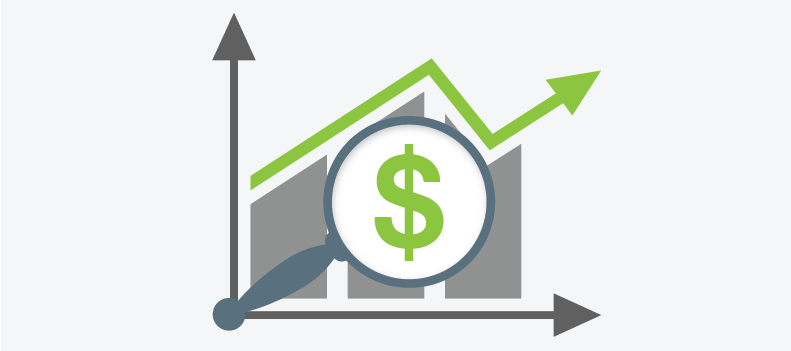Take a moment and think about your favorite brands—what keeps you coming back?
Chances are, it’s not just their products or services, but the way they make you feel and how they choose to engage with you.
That’s the power of customer engagement: it turns every customer interaction into an opportunity to build trust, spark loyalty, and create meaningful, memorable, and genuine connections.
What’s the Difference Between Customer Engagement and Customer Experience?
Before we continue, we’d like to define what customer engagement is. Customer engagement is the active, two-way communication and interaction between customers and brands. The goal of customer engagement is to build meaningful, lasting relationships that truly matter. Customer engagement focuses on “understanding customer needs, preferences and pain points.”
You can tell customers are engaged with your brand if they:
- Are loyal to your brand
- Make repeat purchases
- Express high levels of satisfaction
- Are willing to try new products from your brand
- Provide recommendations to others on sites like Google, Yelp, G2
- Offer valuable feedback on how to improve your products or services
Customer engagement is often confused for customer experience (CX), which is the perception a customer has of a brand based on all the interactions they’ve had with the brand. CX focuses on ensuring smooth and satisfying touchpoints and when done right, it can build a foundation for better customer engagement.
Key Differences Between Customer Engagement and Customer Experience
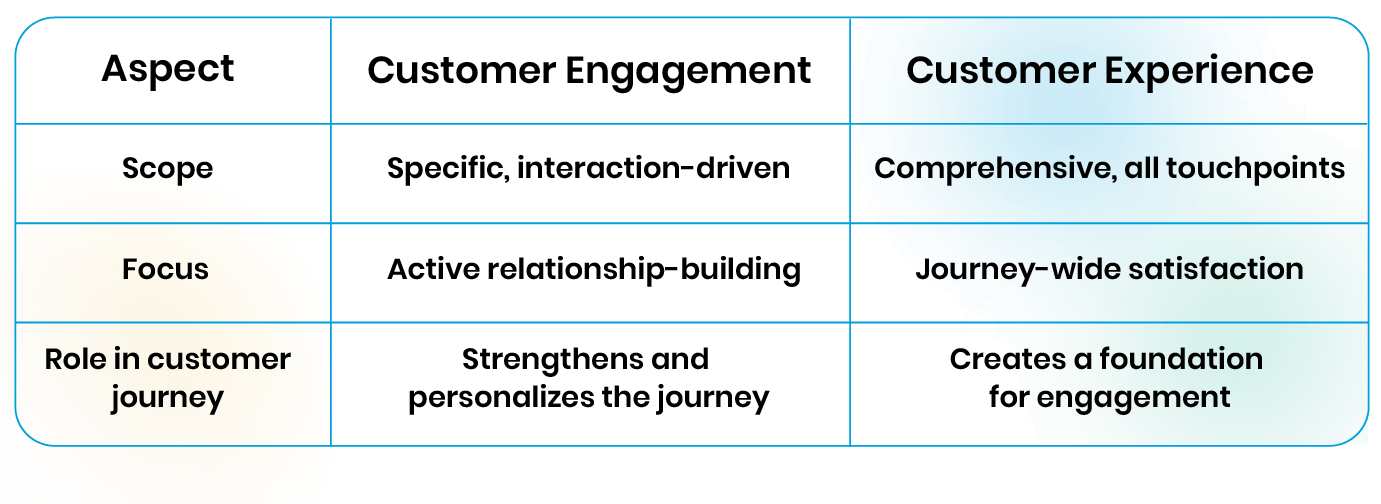
Defining Customer Engagement for Your Business
So, what does customer engagement look like for your business? Is it an active social media presence? A responsive online chat client? Great news—it can be all of these and more!
Some other examples of customer engagement include when customers:
- Open and click through the emails you send
- Frequently visit your website or brick and mortar building
- Take advantage of your customer loyalty program with discounts and free perks
Now, the more genuine and authentic you are in these types of interactions the more likely you are to build loyalty, enhance satisfaction, unlock sustainable growth, and stand out in a competitive market.
Whether you’re shaping a new customer engagement strategy or enhancing your existing efforts, the 48 illuminating statistics we’ve gathered here will provide valuable insights to guide your approach.
Customer Engagement: 48 Key Statistics for Long-Term Success
Why Care About Customer Engagement?
Understanding the benefits of customer engagement inspires impactful strategies.
The following statistics tell us why focusing on customer engagement now is more important than ever before.
- B2B companies that actively engage their customers achieve higher revenue, profitability, and share of wallet, while also experiencing lower customer attrition compared to B2C companies:
(Source: Gallup, Guide to Customer Centricity: Analytics and Advice for B2B Leaders)
- 50% higher revenue/sales
- 34% higher profitability
- 55% higher share of wallet
- 32% fewer days sales outstanding
- 63% lower customer attrition
- 33% greater likelihood to be first choice for future business
- Investing in digital customer engagement can increase revenue by up to 90%. (Source: Twilio, State of Customer Engagement Report 2022)
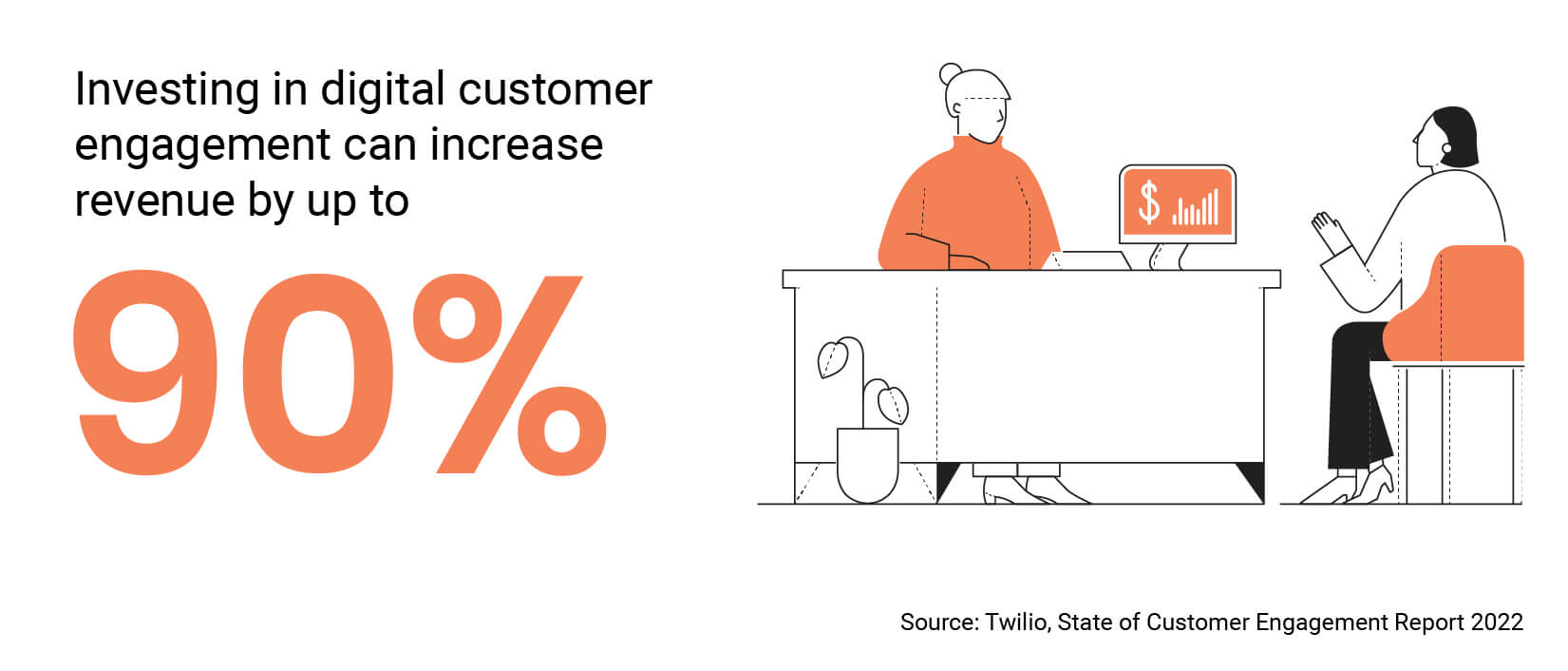
- 82% of B2C companies that had high customer engagement maturity met their financial goals in 2022, compared to only 62% of low-maturity companies. (Source: Twilio, State of Customer Engagement Report 2003)
- Fully engaged restaurant customers—those who have an emotional or rational attachment to a product or business—deliver a 23% higher share of wallet, profitability, revenue, and relationship growth when compared to an average customer. (Source: Gallup, Are Your Customers Coming Back for More?)
- Customers who have positive experiences with your company are likely to spend 140% more than customers who have had negative experiences. (Source: Havard Business Review, The Value of Customer Experience, Quantified)
- Only 29% of B2B customers are fully engaged and 71% are at risk of leaving for a competitor. (Source: Gallup, Guide to Customer Centricity: Analytics and Advice for B2B Leaders)
Challenges in Customer Engagement
Despite the numerous benefits of customer engagement, you may face some challenges that can hinder your efforts. Let’s see what the data tell us about the challenges you may face.
Ultimately, customer engagement depends on the quality of the experience you provide.
The better your experience, the more engaged your customers are likely to be.
- 64% of global consumers say they have avoided a brand in the past year due to a negative experience. (Source: Microsoft, Retail Trends Playbook 2020)
- More than 7 in 10 consumers will move to a competitor after several poor experiences, and over 50% will switch after just one negative encounter. (Source: Zendesk, 92 customer service statistics you need to know in 2025)
- When you surprise and delight your customers, they are 5X as likely to be fully engaged with a brand. (Source: Gallup, The Customer Satisfaction Crisis: Solve It With 3 Strategies)
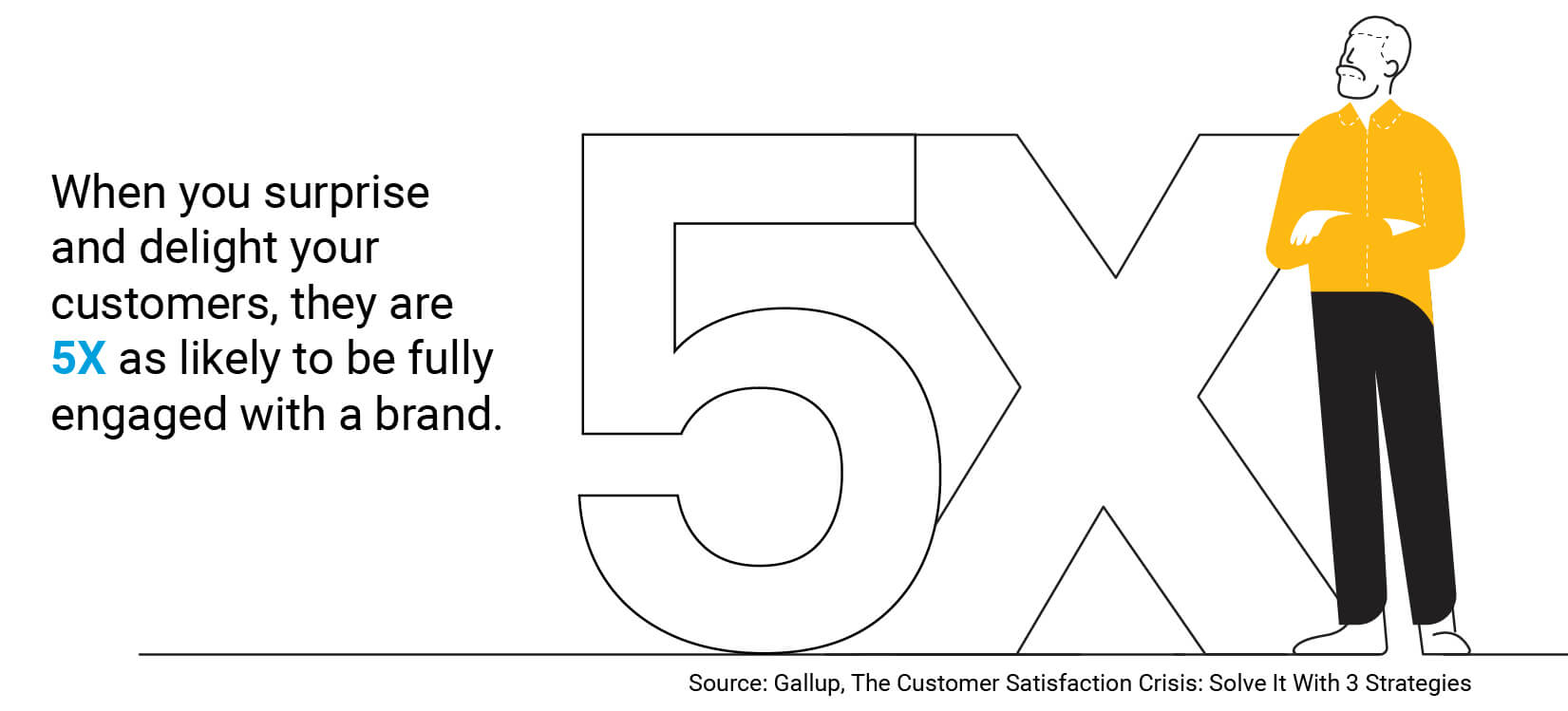
- Customers who report having a poor experience have only a 43% chance of being a customer a year later. (Source: Havard Business Review, The Value of Customer Experience, Quantified)
Your company culture and workforce may be contributing to customer disengagement.
Disengaged employees are less likely to deliver excellent customer experiences, which can, in turn, lead to customer dissatisfaction and disengagement.
On the other hand, let’s explore the positive outcomes of having highly engaged employees who consistently provide exceptional customer experiences.
- Businesses with highly engaged employees achieve 4X more earnings-per-share growth than competitors. They also have 21% higher profits. (Source: Gallup, How a Focus on People’s Strengths Increases Their Work Engagement)
- Highly engaged business units achieve 10% higher customer loyalty and engagement and 18% higher in sales when compared with less engaged business units. (Source: Gallup, What Is Employee Engagement and How Do You Improve It?)
- 94% of customers who rate their customer experience as “very good” are likely to recommend the company to someone as well as purchase more products or services from the company in the future. (Qualtrics XM Institute, ROI of Customer Experience 2020)
Understanding Customer Preferences and Expectations
Understanding and meeting customer expectations and preferences can have an immense influence on how engaged they are with your brand. Let’s see what the data tells us about rising customer expectations, changing preferences, and how addressing them can help boost engagement and your bottom line.
Personalization
- 71% of consumers expect personalization. (Source: McKinsey & Company, The value of getting personalization right—or wrong—is multiplying)
- Companies that get personalization right generate 40% more revenue than average players. (Source: McKinsey & Company, The value of getting personalization right—or wrong—is multiplying)
- 80% of consumers are more likely to buy from a brand if the company offers a personalized experience. (Source: Epsilon, New Epsilon research indicates 80% of consumers are more likely to make a purchase when brands offer personalized experiences)
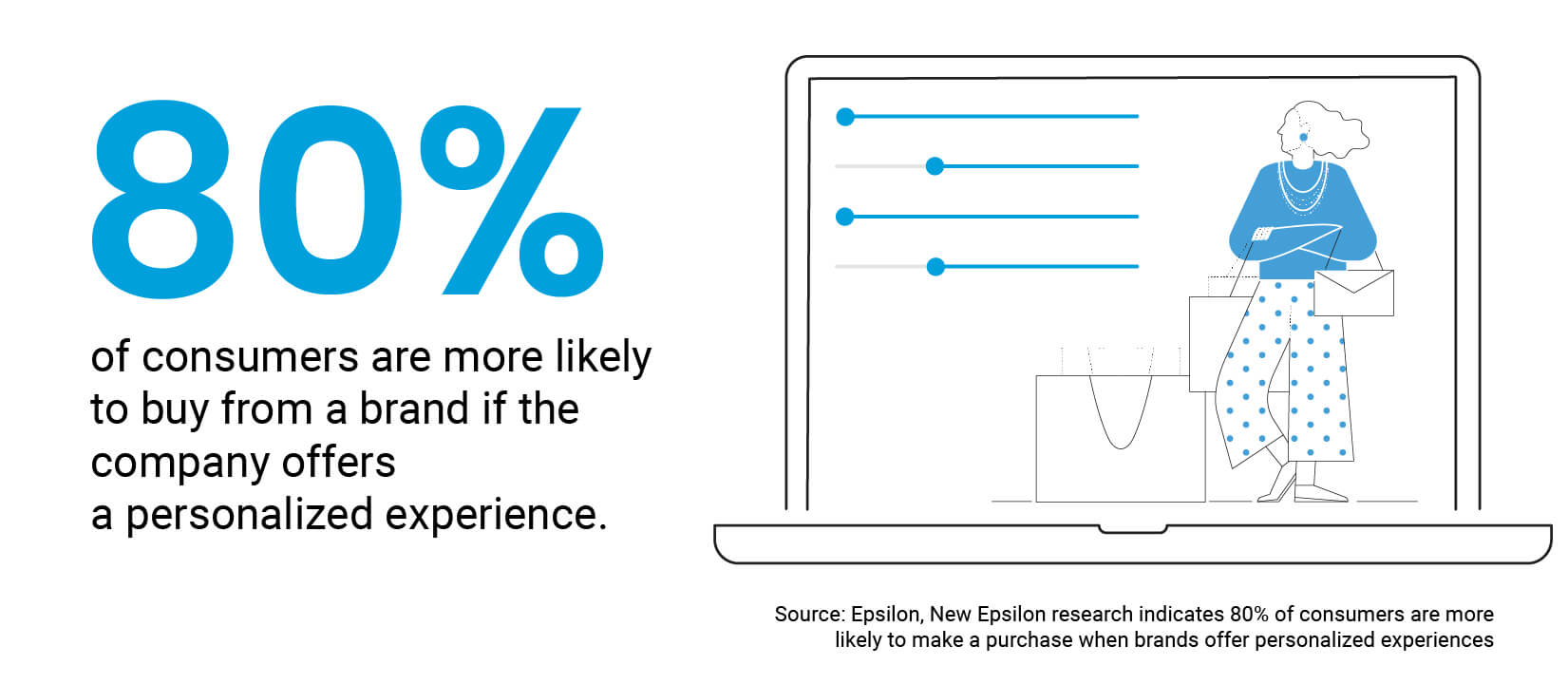
- 70% of consumers say getting personalized product recommendations is “important” or “critical” to meeting their experience expectations. (Source: Adobe, Adobe 2024 Digital Trends Report)
- 51% of consumers believe it’s important to receive a personalized experience from a brand across all their digital channels. (Source: Microsoft, Retail Trends Playbook 2020)
Brand Engagement, Communication, and Generational Preferences
- 90% of customers want brands to engage with them on their preferred channels, such as SMS, social media or chat apps. (Source: Mito, Two-Thirds of Gen Z favor text messaging over email during ecommerce interactions)
- North American consumers are willing to spend 34% more on companies that engage with them in their preferred channels. (Source: Twilio, Consumer Preferences Report)
- If businesses ignore consumer channel preferences, they may lose customers to competition. 24% of consumers say they’ve purchased from a different brand because a business didn’t engage with them via their preferred channel. (Source: Twilio, Consumer Preferences Report)
- Two-thirds of Gen Zers and Millennials prefer communication through text for ecommerce engagement. (Source: Mito, Two-Thirds of Gen Z favor text messaging over email during ecommerce interactions)
- More than 70% of Millennials state that a phone call is not their preferred method for resolving customer service issues. (Source: IBM, Reinventing the Contact Center: How AI Enhances Experiences During Turbulent Times)
- Almost 95% of customers engage with companies via email, and 88% engage by phone. (Source: Salesforce, State of the AI Connected Customer)
- Email is a popular channel across all generations! 87% of Baby Boomers, 83% of Gen Xers, 77% of Millennials, and 70% of Gen Zers saying email is their preferred channel. (Source: Twilio, Consumer Preferences Report)
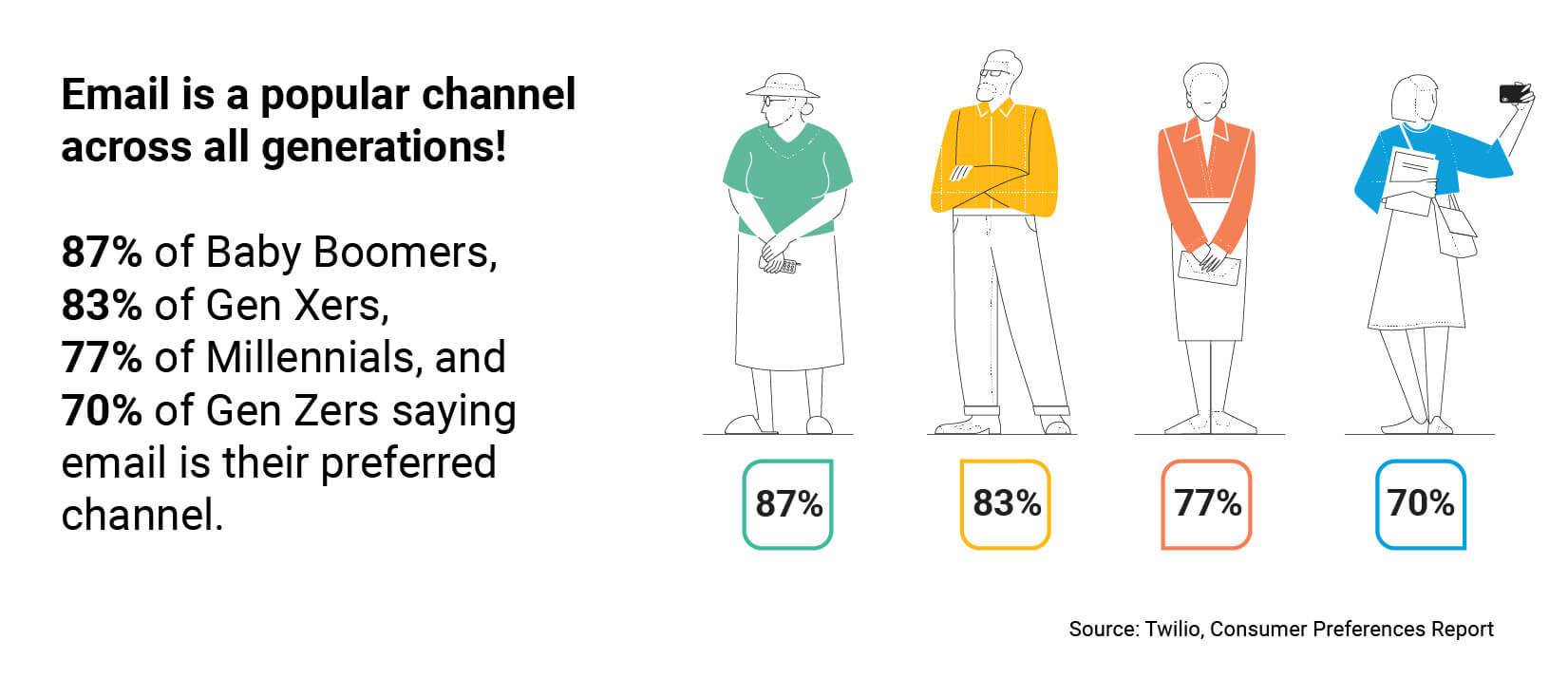
- Social media DMs are the preferred way for 1 in 5 Gen Z, Millennials, and Gen X to engage with customer service from a business. (HubSpot, State of Consumer Trends)
- All generations have a sweet spot for direct mail. 71% of all consumers are excited to discover what the mail brings every day. (Source: USPS, Generational Research Report)
- 72% of Gen Zers, 71% of Millennials, 76% of Gen Xers, and 89% of Boomers say the most effective type of direct mail they receive are deals. Surprisingly, Millennials are the most likely generation to act after getting direct mail, with 47% visiting a website, 36% sharing it, and 28% shopping in-store. (Source: USPS, Generational Research Report)
10 Strategies for Improving Customer Engagement
Now that we’ve provided the stats to show you why customer engagement is so important, let’s dive into ten strategies that can help you design an engagement blueprint for success.
Personalize communications
Build a sense of connection and loyalty with your customers by personalizing emails, offers, and every interaction possible.
Implement a loyalty program
Offering your customers any type of benefit from purchasing from your brand, such as points-based rewards and exclusive discounts, will help them feel valued.
Use social media for direct engagement
Stay active on all of your social media accounts by posting engaging content, responding to comments, and using tools like polls.
Send follow-up emails
Be sure to schedule follow-up emails after they purchase something to show you care about your customers’ experience with your brand.
Create valuable content
Establish yourself as an expert in your industry. You can share helpful blog posts and tips that are relevant to your customers’ interests.
Host webinars or live demos:
Give your customers an opportunity to engage with your brand in real time by hosting webinars or product demonstrations of your products or services.
Offer multi-channel customer support
Allow your customer to reach you in a variety of ways, such as by email, phone, social media, or live chat.
Optimize mobile engagement
Ensure your customers’ mobile phone experience is seamless by optimizing your brand’s website for mobile viewing.
Run exclusive promotions for subscribers
Make your customers feel like they’re part of something special by offering exclusive offers, early access to sales, or subscriber-only discounts.
Encourage and display customer reviews
Establish your brand’s credibility to responding to online reviews and feature those positive reviews as testimonials on your website.

Turn Customer Engagement Insights into Action
These statistics emphasize the integral role customer engagement plays in the success of your business. From more responsive social media communication to designing a loyalty program, effective engagement strategies can significantly impact your business’s growth.
Challenges such as personalization and employee engagement underscore the need to focus on customer preferences and leverage technology wisely. By understanding and applying these insights consistently, you can drastically improve your customer engagement efforts and stay ahead of the competition.
Ultimately, prioritizing engagement enables you to foster stronger, more meaningful relationships with your customers, creating a foundation for a successful future.




